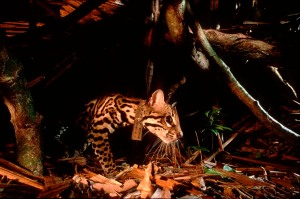Our principal study system consists of a large-seeded palm species (Astrocaryum standleyanum), a large scatter-hoarding rodent (the Central-American agouti, Dasyprocta punctata) and a large cat (the ocelot, Felis pardalis). So we have a resource, a herbivore and a predator: a tritrophic system.

Astrocaryum fruits on the ground
Astrocaryum standleyanum is a tree-shaped palm that occurs from Nicaragua to Colombia. It is one of the most abundant tree species in central Panama. On BCI, adult palms produce up to eight infructescences with up to 500 bright orange fruits each. The fruits ripen mainly during April-June. Inside each fruit is one 2 cm long seed, that sits enclosed in a very hard endocarp (“nut”). The fruit pulp as well as the seeds are important food resources for frugivorous and granivorous mammals.

Agouti eating Astrocaryum fruits (c) Christian Ziegler
The Central American agouti is a caviomorph rodent weighing 2-4 kg. Agoutis are common in most Neotropical forests and are important as prey species, seed predators and seed dispersers. Agoutis scatter hoard seeds of many plant species, but fancy especially nuts of Astrocaryum. They hoard these nuts as food supplies for the late wet season, when the forest produces little fruit, and they do so by burying seeds in the ground all across the forest, every nut in a different spot. Not all seeds are ultimately recovered and eaten. Those seeds that “escape” find themselves dispersd and planted, and can establish as seedlings. It is believed that Astrocaryum heavily depends on agoutis for seed dispersal.

Ocelot (c) Christian Ziegler
The ocelot, weight 9-14 kg, ranges from Mexico to Brazil. It is the most abundant cat on BCI, with over 30 individuals. Each ocelot has a unique spot pattern by which they can be recognized. Most of the BCI ocelots have a name. Ocelots eat rodents, sloths, reptiles, amphibians, birds, monkeys, small deer, and even fish. They hunt mostly during the night but we also capture them on our camera traps during plain day. Ocelots are by far the most important predators of agoutis. Agoutis have to continuously watch out for them when they forage to not get killed.










June 8, 2010 at 14:33
thiz iz th3 most cute cat i`ve never seen!!!
June 8, 2010 at 14:36
this is sooooo cute